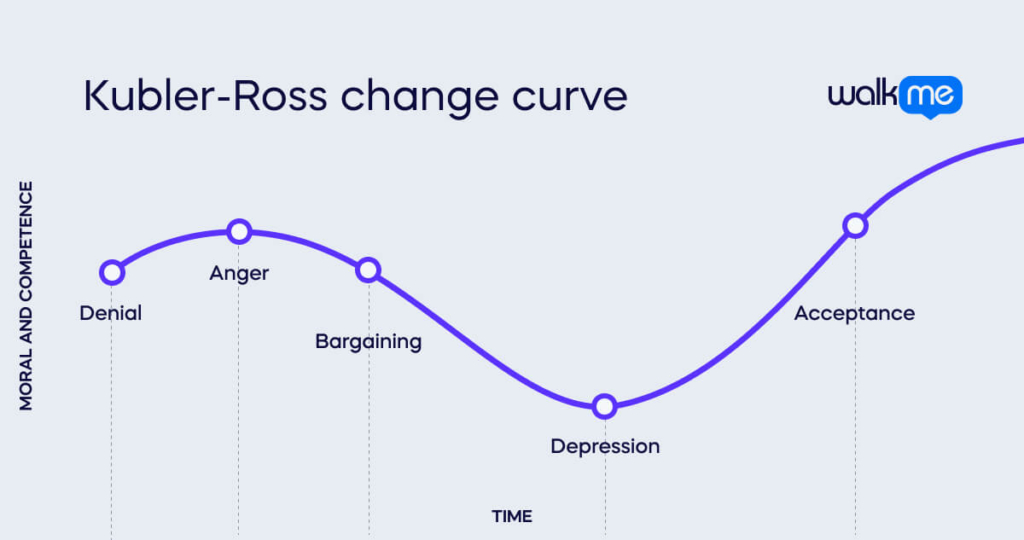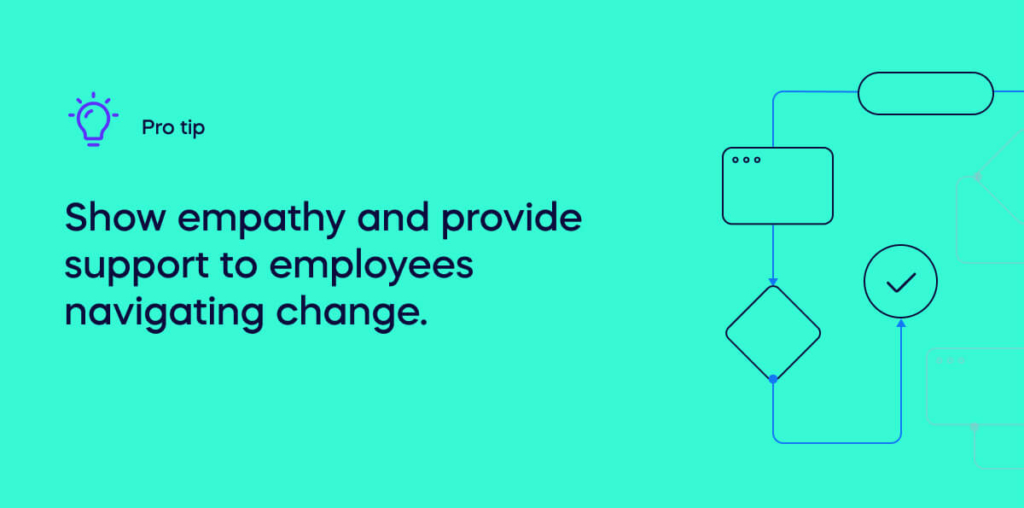Organizational development is already difficult enough before you factor in the emotions, conflict, and resistance from your employees swirled into the mix.
It may feel like you’re constantly pushing against the tide, trying to get everyone on board with organizational changes and moving in the best direction for your company.
For these reasons, many change leaders (intentionally or otherwise) outright ignore employees’ emotional responses to organizational change.
Maybe it’s because they don’t know how to deal with those emotions. Maybe it’s because they don’t care. Maybe that’s why only 34% of change initiatives are successful.
But what if there was another way?
What if embracing feelings such as frustration, anxiety, fear, disbelief, and acceptance could actually aid in managing organizational change?
That’s where the Kubler-Ross Change Curve comes into play.
This powerful tool provides an empathetic approach to change management by identifying stages along the employee journey toward adjusting to organizational changes.
By understanding the Kubler-Ross change curve, you can lead more effective, human-centric change management.
In this article, we’re reviewing everything you need to know about the Kubler-Ross Change Curve. There are, of course, many other options for change management models, but today we’re talking about Kubler-Ross.
We’ll also provide actionable steps to use its principles to better manage people throughout the life cycle of a new change initiative within your organization.
The Kubler-Ross change curve: What is it and why is it important for change management?
Change is inevitable.
We’ve all experienced it, whether trying a new food or starting a new job.
Yet, change can be difficult to endure, especially within organizations where it can impact everything from the company’s culture to its bottom line.
This is where the Kubler-Ross Change Curve comes in. Developed by psychiatrist Elisabeth Kubler-Ross, the curve is a framework for understanding the emotions people experience during change.
It begins with denial and ends with acceptance, with several stages in between.
Many leaders fail to recognize the importance of empathy during times of change. Instead, they focus solely on the end goal, forgetting about the human element and the emotions their employees are experiencing.
By understanding the Change Curve and practicing empathy, you can navigate change more effectively and create a positive outcome for all involved.
Kubler-Ross change curve: Explaining the five stages of grief

The Kubler-Ross change curve outlines the five stages of grief as follows:
- Denial
- Anger
- Bargaining
- Depression
- Acceptance
It’s important to note that moving through these stages isn’t linear.
You may find your employees going back and forth between stages or experiencing them all at once.
Let’s drill down into each stage in more detail:
Stage 1: Denial
This initial stage of the Kubler-Ross Change Curve is marked by disbelief and denial.
Employees may be in shock at the sudden change and unable to process it, feeling overwhelmed by what’s happening.
At this point, they are likely to reject any information about the changes.
In order to move through this stage successfully, it’s important for you to be understanding of your employees’ denial and provide reassurance that things will eventually make sense.
You should also provide clear information about the changes and help staff understand why the change is necessary. This will help ease employees into the transition process and give them a sense of control.
It’s also important to provide an open forum for employees to express their feelings and find support from colleagues who may be feeling similarly.
Doing this will help create an atmosphere of understanding during times of change, which can aid the transition process.
Stage 2: Anger
When employees cannot deny it any longer, they may become angry and frustrated.
This is a natural response to change, and it’s important for you to be understanding of your staff’s feelings.
It’s also important to remember that anger isn’t necessarily bad–it can help propel the change process forward by giving people the energy needed to move through the stages.
You should use this energy in a constructive way by encouraging open dialogue and providing clear guidance throughout the transition process.
You should also strive to ensure everyone involved feels heard and considered during the decision-making processes associated with organizational transformation initiatives.
Doing this will foster an environment of respect and understanding.
Stage 3: Bargaining
At this stage, employees may attempt to negotiate their way out of the situation by attempting to make deals or compromises with higher-level management.
Leaders should be aware of this tendency and strive to provide clear information about why the change is necessary.
It’s also important for them to stay focused on the goal at hand and remain firm in their decisions.
Doing so will help ensure that employees understand that there is no negotiating regarding organizational changes.
Stage 4: Depression
During this stage, employees may become overwhelmed by a sense of hopelessness and despair as they face the reality that things will never be the same.
You should strive to create an environment of comfort and understanding where employees can express their feelings without fear of judgment.
Creating a support system where employees can rely on each other for guidance during this difficult time can also help them move through this stage more successfully.
Stage 5: Acceptance
Once all stages have been experienced, employees may finally reach a point of acceptance and come to terms with the changes made.
At this stage, it’s important for leaders to provide clear guidance about how to move forward and continue progressing as an organization.
Doing so will help ensure everyone is on the same page and working together towards success.
With the right tools and support, employees can accept the changes and move forward with a renewed sense of purpose.
How to apply the Kubler-Ross change curve
While initially developed to help individuals cope with grief, the Kubler-Ross change curve is also a helpful tool in business.
It can help you understand the change process and help your employees prepare for it.
You should strive to ensure that your employees are educated on the Kubler-Ross Change Curve and provide support throughout each process stage.
Doing so will help foster an environment of understanding and acceptance, essential for successful organizational change.
Applying the Kubler-Ross Change Curve to your organizational change management strategy requires empathy, patience, and a willingness to see things from your employees’ perspectives.
If you’re looking for an approach to change management that’s a little more enterprise-focused, Gartner’s organizational change guidance outlines an “open-source change” strategy that aligns closely with Agile principles. It encourages early transparency and employee-led change, allowing an organization to make faster and adapt quickly.
Whatever you choose, it’s worth it— the payoff is a transition that is less chaotic, less stressful, and more often successful.
Supporting employees through every stage of change: Tips for leaders

As leaders, we are responsible for supporting our employees through every stage of change.
You may get frustrated when you encounter resistance or confusion, but it’s important to remember that change is difficult for everyone.
As a leader, you need to approach each employee with empathy, understanding, and a willingness to help them through the process.
This may involve extra coaching, resources, or just an ear to listen.
Whatever tools you use, the important thing is to remember that each employee is unique and deserves your support as they navigate the changes that are happening around them.
You need to be there for them every step of the way.
Change management, but for humans
Knowing how to use the Kubler-Ross Change Curve as a framework for organizational change management can make dealing with challenging times easier.
It’s important to recognize the five stages of grief and understand their unique characteristics in order to craft an effective strategy.
You need to remember that it is important to focus on empathetic communication and applying reasonable solutions while inspiring hope when people encounter resistance during times of change.
When employees seem overwhelmed by feelings related to the transition, you have a responsibility to support them in seeking professional help.
Doing so will ensure that everyone involved is cared for, allowing them to look forward positively and confidently embrace any new changes.
The change curve is important for understanding how people react to organizational transformation initiatives.
By following these guidelines, you can ensure that you provide your staff with all of the necessary support throughout times of upheaval and transition.
Doing so will enable you to create an environment where everyone is on board with any changes that take place – setting up your business for ongoing success.

